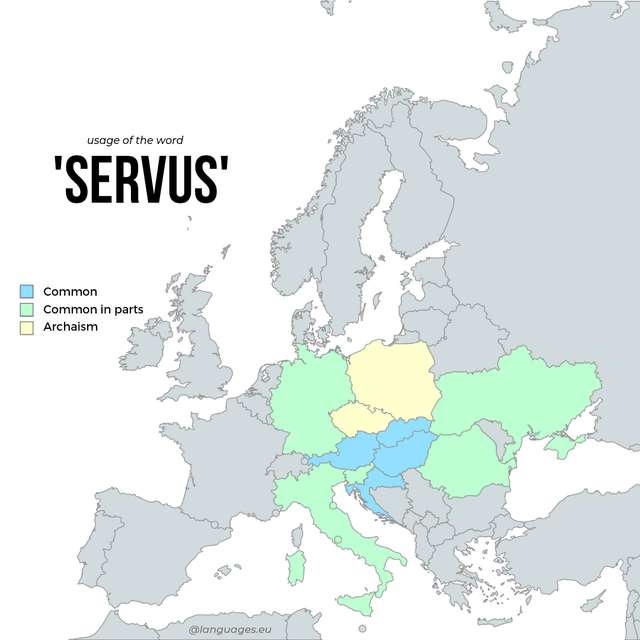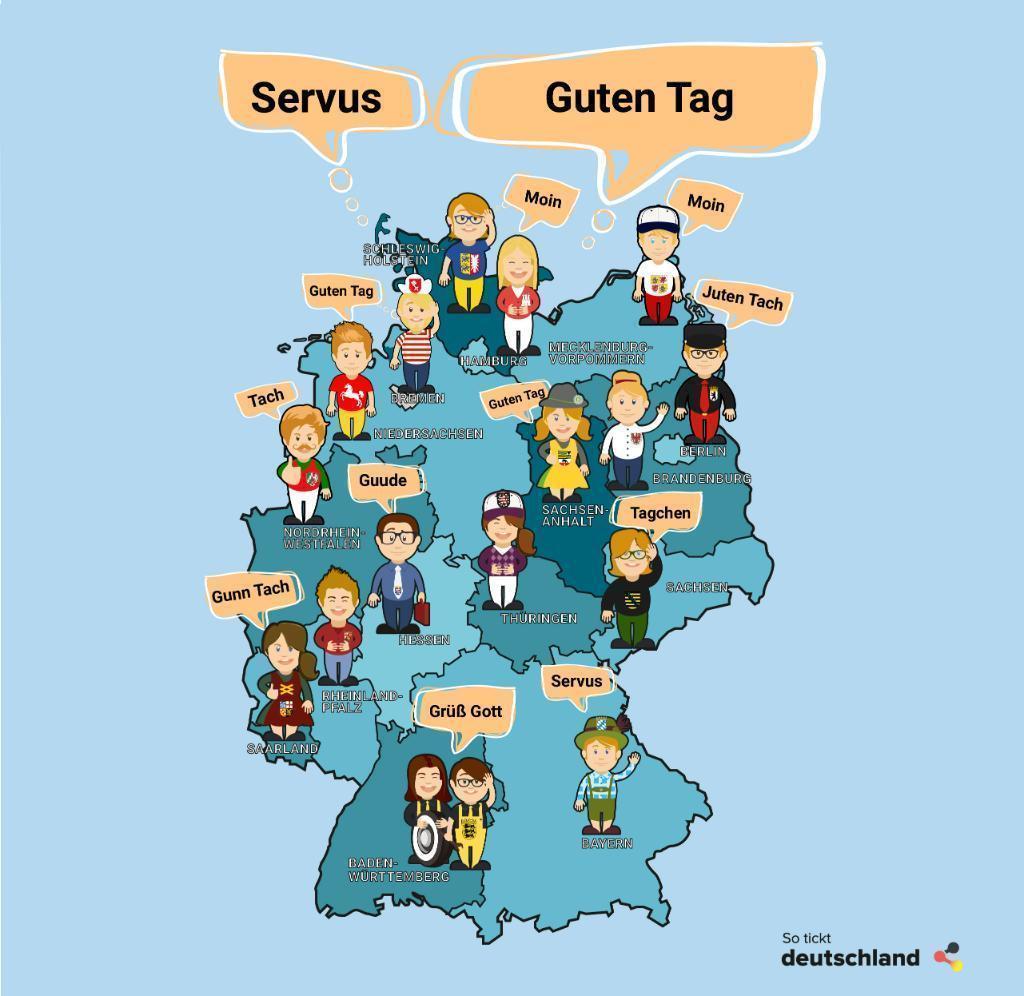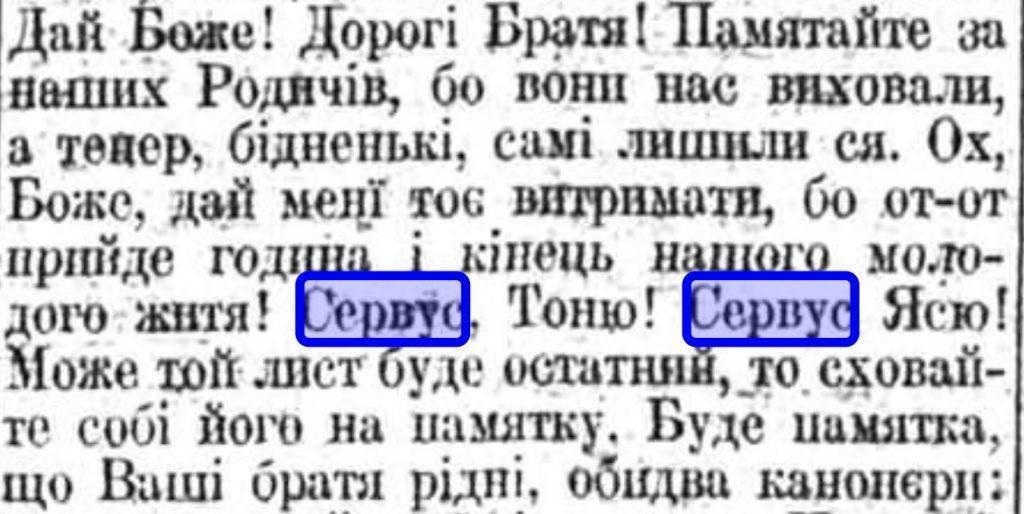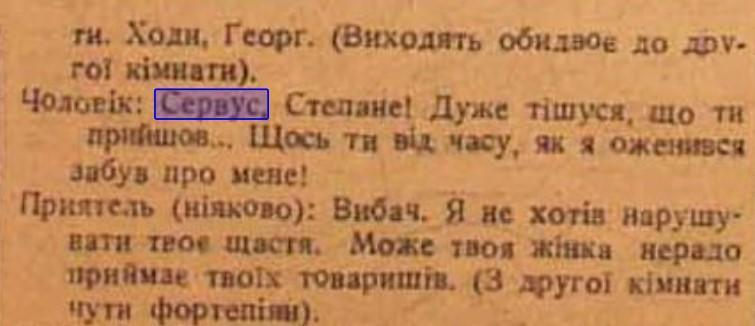Servus! This article is about a Galician tradition that can be found on both sides of the current Polish-Ukrainian border. It is about the word “servus,” a salutation typically used as a greeting, which gained popularity during the times of the Austro-Hungarian Empire and which became common across its entire territory. While the word has now fallen into disuse in part of its former range, in some regions it can still be heard to this day.
Origins of Servus
The word is in fact an ellipses of the Latin expression servus humillimus, Domine spectabilis (your most humble servant, my noble lord), which was used by commoners greeting their lords. The word “servus” itself means “servant” or “slave.” (“Servus” is also the origin of the word “serf.”) Over time, the greeting evolved and all meaning of subservience completely disappeared. Instead, in modern usage it took on the meaning “at your service,” or simply “hello.”
The Germans of the Austrian Empire first greeted people they especially respected in this way, and later close friends and family members. From German, the greeting spread to all the languages of the Danube basin.
Servus Today
Today the greeting is still commonly used in Austria, Hungary, Slovakia, Romania (mostly in Transylvania), as well as in southern parts of Germany, northern Croatia, and eastern Slovenia. It may also be heard in the Czech Republic, Poland, and western Ukraine, but in these places it is considered an archaism and not used in common speech.
Below is a map I found of the usage of “servus” – though I don’t agree with it being “common in parts” of Ukraine. Instead, I would group it with Poland and the Czech Republic.

In the German language, “servus” is still used mainly in southern, Catholic regions, such as Bavaria. In Austria and the Italian South Tyrol, it is generally one of the most popular forms of greeting. In Austria some people use the contracted versions “servas,” “sers,” or “seas.” And there it can also be used to say goodbye. “Servus” has even been immortalized in numerous Viennese songs, such as “Sag beim Abschiedleise Servus” (Say softly Servus at the farewell).

Hungarian also has the word “szervusz,” but its shortened versions such as “szia” and “szió” are more popular. A variation of this is also used in Zakarpattia (“sio,” Cyrillic “сіо”), a territory in western Ukraine which has a long history of Hungarian influence and which was in the Hungarian part of Austria-Hungary.
Slavs use “servus” less than their German counterparts: In Czech “servus” is considered an archaism. In Slovak, “servus” is still used, but competes with “ahoj” and “čau” (from the Italian “ciao,” which by the way has a similar origin to servus, derived from s-ciào vostro or s-ciào su literally meaning “(I am) your slave.” Parallel forms “servus/serbus” are still used in Slovenia, Croatia, and some parts of Romania.
In Polish Galicia, instead of “serwus,” Poles now mostly say “cześć.” While in Ukrainian Galicia, “привіт” (pryvit) is now the common greeting. More on Polish and Ukrainian usage below.
Polish Usage
Narodowe Centrum Kultury (Poland’s National Center for Culture) describes the history of Polish usage as follows: “Even at the end of the 20th century, you would use the word ‘serwus’ when you met a good acquaintance, especially one you haven’t seen in a long time. Bah! Some people still say it today! Where did it come from? ‘Serwus’ is a direct borrowing from school Latin: the Latin word ‘servus’ means ‘servant.’ And do you remember how the heroes in Sienkiewicz’s Trilogy addressed each other, how the heroes of Prus greeted each other? They said, ‘I am your humble servant!’ ‘Serwus’ is therefore a kind of translation: a transformation of the polite, welcoming, masculine [grammatical gender] ‘Sługa!’ [servant] into the quasi-Latin ‘serwus’ (servus) that was used by schoolboys and students. In this usage, the humorous ‘serwus’ appeared in schools in Galicia in the 19th century. It quickly spread to everyday language, even finding its way into the first 20th-century dictionary of the Polish language (the so-called Warsaw Dictionary). With time, it lost its playful character, became commonplace and, inevitably, began to fall out of use, but at the same time became old-fashioned and today sounds archaic: like a ‘Hey!’ from the old days” (NCK).
As for my encounters with the word in Poland, I have been greeted by a few of my Polish blog followers this way (though of course these are people with a keen interest in Austro-Hungarian history, so no surprise here). When I asked my Polish IT work colleagues about it, they all said they know it, but consider it archaic and never use it. On the other hand, some other acquaintances of my generation do use in on occasion (and they do not necessarily have a special interest in history).
Ukrainian Usage
Ukrainians traditionally used religious greetings such as “Слава Ісусу Христу” (Glory to Jesus Christ) and “Дай Боже здоровля” (May God give you health). Secular greetings took root slowly, and in general they have a foreign origin. Such is the case with “servus” (сервус): at first it was used only in cities, especially by non-Ukrainians, but over time it entered the Ukrainian vernacular as a less formal, more relaxed greeting.
Specifically, it was a common greeting among gymnasium and university students in Galician Ukraine. Eventually, it spread and became a greeting among intellectuals, artists, poets, writers. Some would say it to impress others, to show off that they had achieved a higher level of education. It ended up being passed from generation to generation as a more “upper class” or intellectual greeting among friends and colleagues.
While in Poland the word spread beyond Galicia, in Ukraine, as far as I know, the word never took root outside of western Ukraine.
Many members of the intelligentsia fled Ukraine during WWII, and so it is no surprise that this word continued to be used in the diaspora for many decades. Only relatively recently did it start to pass into oblivion. In Ukraine, however, it fell into disuse quicker.
During my 11+ years living in Ukraine, I have never heard anyone say “servus.” And when I recently asked several of my friends and Ukrainian IT work colleagues, practically none had ever heard it before, let alone use it.
My only encounters with the word in Ukraine are in written texts – in some historical references (old newspapers), or for example, in a recent book about historical Galician cuisine.



And while researching the word for this article, I came across this song by the Ukrainian band Plach Yeremiyi “Сервус, пане Воргол” (Servus, Mr. Warhol) (Andy Warhol’s parents were Lemko from Austria-Hungary.)
Poll on Usage among Polish- and Ukrainian-speaking Instagram followers
I recently polled my Polish-speaking and Ukrainian-speaking Instagram followers on their usage of the word “serwus” and “сервус,” respectively: I asked them whether they know and use it, know it but don’t use it, or have never heard it.
While the poll was neither reflective of the wider society (it was not a representative sampling) nor very accurate (due to my ambiguously phrased questions – by not specifying it should be native speakers, many followers answered both polls), it did give me insight into usage among my audience. I was surprised to discover that more followers than I expected actually use this word (among both Polish and Ukrainian followers – though the percentage of Polish speakers using it as compared to their Ukrainian counterparts is significantly higher, as expected). Otherwise, the other data from the polls only confirmed what I had encountered and read about the word: 1) A huge majority of Poles were familiar with the word, with just a tiny percentage saying they never heard it before; and 2) More than half of Ukrainian speakers had never heard the word before.
***
“Servus” is a small word with a long history, a trace of the former Austrian-Hungarian Empire that can still be found in many former crownlands and territories. While still encountered in Galicia, especially among Polish-speakers, here it has largely become an archaism: on the Polish side, “serwus” is fairly well known but not very commonly used, while on the Ukrainian side, “сервус” sadly is neither commonly used nor well known.
But I think it is not too late to see it make a comeback in Galicia, for it to come back into fashion. I hope more people will learn about its history and usage and add it to their vocabulary.
I personally am a big fan of the greeting – I am always delighted when someone says it to me, for I feel as if I am being greeted from the olden days, the days of the Kingdom of Galicia and Lodomeria.
#servus #bringbackservustogalicia #makeservusgreatagain #makeservususedagain
By Areta Kovalska
See also:
Sources:
“Servus,” Wikipedia
Usage of the word “Servus,” Reddit
“Serwus, Nerwus,” NCK
“Сервус,” По-нашому
“Word of the week: Servus”
Map in featured image:
“Distribution of Races in Austria-Hungary” From The Historical Atlas by William R. Shepherd, 1911.






Very good article, thank You, dziekuję bardzo.
I would add an information. There is in Hungarian a word that derives from the Austrian pronunciation of „servus” I discovered about 2 years ago in an Austrian movie: it is „szevasz”. It appeared,I believe, before the short „szia”, which might be a modern, 20th century variation.
Dear Zoltán,
if you heard the variation in an Austrian movie, it was probably “Seavas”, which is simply our Viennese/eastern Austrian dialect pronunciation of “Servus” (German ‘s’ = Hungarian ‘sz’).
When I visited together with my wife the city of Satu Mare/Szatmárnémeti some years ago, we met a journalist from Cluj/Kolozsvár/Klausenburg. Although she does not speak Hungarian, she greeted her friends with the Hungarian “Szervusz” and was completely amazed when she learnt that we use “Servus” in Austria, too. 🙂
Servus from Vienna!
Regarding comments about Hungarian versions. Szevasz was a common variant, still heard today, a somewhat less formal version more popular with young people in the 50’s. In the late 60’s the English hello and see ya became popular, (szia , hello), but humorously they were knowingly transposed to the chagrin of English speaking friends. No amount of correcting would change this, eliciting only a laugh.
Сервус! My father and his friends greeted each other with this word throughout my childhood in the Ukrainian Diaspora. How surprised I was to come across it in an “Asterix and Obelix” comic book while we lived in Europe in the 1970s! It was used by a Roman Centurion to greet the chief of the Gaulish village. Now in my early 60’s, I’ve taught some of my Ukrainian friends from other diasporas (e.g. former Yugoslavia) the word in the hope that it can be revived.
I’m from Transcarpathia, and Servus is a commonly used greeting in my region and in my family. It’s just a normal greeting for us, and we never considered it as showing off. We also use Hungarian sziá, as well as Ukrainian pryvit, and chao a lot.
By the way, Servus pane Warhol is a song with lyrics by the famous Transcarpathian poet Petro Midyanka.
Grandpas in our region also use my favorite Hungarian greeting, “Kezét csókolom,” or just “Csókolom,” which literally means, “I kiss your hand.” It’s a shame that we almost abandoned this greeting nowadays.